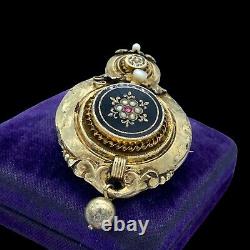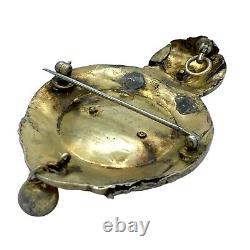
- Home
- Characteristics
- Format
- Material
- Signed
- Store Category
- Type
- Anneau Simple (15)
- Art Tile (20)
- Bague (18)
- Bague Sertie (35)
- Bracelet (40)
- Broche (31)
- Carreau D’art (151)
- Chaise (17)
- Collier (16)
- Dessin (17)
- Lampe De Table (23)
- Mural (18)
- Oil (15)
- Poêle à Bois (50)
- Sculpture (177)
- Set Ring (15)
- Suspension, Lustre (21)
- Table + 2 Sellettes (35)
- Tableware, Kitchen (16)
- Tiles (18)
- Other (2735)
Antique Vintage Art New 14k Gf Etruscan Akoya Pearl Enamel Brooch 13.8g





Antique vintage art nouveau 14k gf Etruscan akoya pearl enamel brooch 13.8g. This product sheet is originally written in English.
Please find below a machine translation in French. If you have any questions please contact us.We have similar Etruscan articles and art nouveau, which would fit well with this piece, on sale this week. To view separate lists, please visit our store and search for "strusk" or "new" under our articles. Description of the ad by: cameron j.
Markings: unmarked, tested and guaranteed. Main stone: pearl of akoya. Measurements/color of the main stone. Diameter: 1.3 mm to 3.73 mm.Measurements/color of the accent stone. Stone treatment: the stone or stones seem not to have been treated, but we are not certified gemologists. The stones were tested and guaranteed using a professional refraction, heat and hardness tester presidium duo.
Stone sizes: polished round beads and glass bead. Handmade at the time of art nouveau in the style of Etruscan renaissance. Composed of 14 carat yellow gold filled on a base metal.
Presents a round design with black enamel that contrasts beautifully with gold. Nine beautiful akoya beads are placed on the pin. A small pink glass stone is placed in the direct center of the pin.
Foiled motifs and twisted cord motifs decorate the pin in the classic Etruscan style. Complete with a pin rod and a closed "c" clasp for a safe port. Damage: wear adapted to age.There is wear when filling gold and the base metal is visible in some areas. The pin is heavily bumped and the rear panel takes off slightly upwards. The price was reduced to reflect this. This list is for the article only. Not all photo displays and/or accessories are provided with your purchase.
It was very true because of the beautiful designs that came out of this period. This time was centered on women and the beauty of nature and the pieces were often large. The enamel was a material commonly used in art nouveau jewellery, as the period was more focused on the importance of design than on the materials used to create it. The art nouveau period took place before the beginning of the First World War, when mass manufacturing took over the production of many products, including some jewellery.
The neo-strusc jewels were popularized for the first time in the early 1800s when an Etruscan tomb was discovered just outside Roma. When she was discovered, the jewellers worked to imitate and understand the working techniques of the metals with which the jewels were made. Etruscan jewellery was not only a luxurious addition to Victorian styles of the time. But he introduced new ideas and decorations. These Etruscan tombs contained jewels decorated with long and fluid geometric lines and patterns, mythological images and landscapes, and celestial elements.The techniques of repulse, watermark and granulation are all attributed to the Etruscans. Akoya saltwater beads are grown from akoya oyster and are mainly in Japan and China. They are known for their beautiful round shape and exquisite brilliance that distinguish them from many other types of pearls.
They are usually white or creamy, but can have pink or silvery shades. At the time art deco, akoya pearls were rare, expensive to possess and reserved for the richest of the rich. The enamelling dates back to the ancient Persians of meenakari. The technique consists of sticking powdered glass on a base, usually gold, by cooking (heating and melting glass on metal). The glass hardens to form a layer of pigment on the metal.
The enamel is made of coloured powdered glass or may include transparent powdered glass mixed with coloured metal pigments. It was used by ancient Egyptians, Greeks and Celts; and later Chinese and Georgians. It regained popularity in the 20th century. It is mainly used on decorative art or jewelry, usually of small size.
In addition to jewellery, enamel can also be applied to glass, ceramics, stone and various other materials. National United States: All items are shipped within one business day of receipt of payment. We do not underestimate packages for customs, please do not ask us to do so. What you pay is what we will ask on your customs form.
Please take this into account before placing your bid. If you need more time to pay, please contact us before you bid. The enamelling dates back to the ancient Persians of mee. This item is in the category "Bijoux, watches\joaillerie\broches, pin's\others". The seller is "abeautifultimeco" and is located in this country: us.
This item can be shipped to the following country: whole world.-
Ancient: yes
- metal base: unknown Secondary stone: glass Metal purity: 14k
- vintage: yes Jewellery department: fine Material: enamelled
- metal: solid yellow gold
- country/region of manufacture: unknown Age: art nouveau (1890-1910) Type: pin
- mark: unknown Dominant stone: akoya pearl

